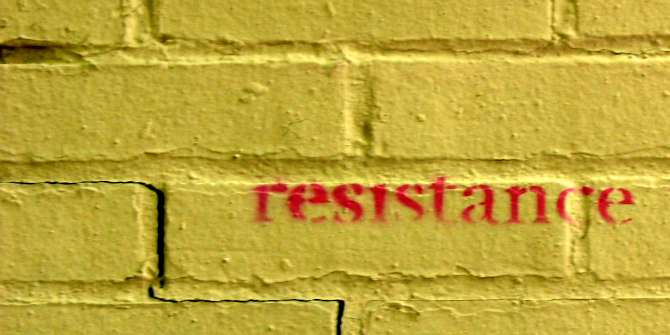A “border” is a powerful and versatile concept, variously invoked as the delineation of geographical territories, as a judicial marker of citizenship, and as an ideological trope for defining inclusion and exclusion. It has implications for both the empowerment and subjugation of any given populace. Anyone interested in the power of border symbology, especially in communication, geography, social movements, migration, and mobility studies would benefit greatly from reading Border Rhetorics , writes Ulises Moreno-Tabarez.
 Border Rhetorics: Citizenship and Identity on the US-Mexico Frontier. D. Robert DeChaine (ed.). University of Alabama Press. August 2012.
Border Rhetorics: Citizenship and Identity on the US-Mexico Frontier. D. Robert DeChaine (ed.). University of Alabama Press. August 2012.
With so much of the literature on immigration and borders concerned with legal status, family ties, and economic migration, D. Robert DeChaine‘s edited volume stands out as an important contribution for the way it examines the US-Mexico border as it functions in the rhetorical production of civic unity in the United States. DeChaine’s heuristic body of work surrounding border symbolism informs the stretching of the ‘border’ trope to lay claim to this important argument: ‘border symbolism constitutes a powerful form of social sense-making—a public doxa’ (p. 2).
The essays explore thematically different facets of border rhetorics, including conceptual, historical, legal, performative, and media. This book review only takes up the conceptual theme to explore the book’s scope and significance. Offered as ‘starting points’ for analysis are three essays authored by Kent A. Ono, Julia R. Johnson, and Karma R. Chávez. Their essays constitute imperative re-conceptualisations of border rhetorics and of rhetorical studies at large.
In his article, Ono argues for a re-conceptualisation of the US-Mexico borders beyond their literal physical locations. Ono is concerned with the figurative aspects of the border and the roles discourse plays in shifting borders and bordering processes beyond the Southwest. Thus, Ono calls attention to the ways in which the US-Mexico border is enforced and policed across the US nation state. The logic that borders are not necessary for border enforcement is palpable when he notes that ‘enforcement and surveillance’ extends to the east, midwest, and south of the United States. For Ono, this illustrates the reality that migrants carry borders, along with all the exclusionary implications, with them where they go. This also leads Ono to consider the body as an extension of the border, which means that bodies are subjected to exclusionary discursive practises surrounding identity markers such as race, gender, and sexuality, among others.
Ono’s article offers a substantial model to stretch ‘bordering’ as a critical trope. This might lead future critics to conceive of borders as existing beyond national lines, an observation that can be made to enhance Ono’s own project. That is to say, it is improper to claim that laws in Mexico and the United States determine the rights only of its respective citizens, as he does (p. 21). Although referenced, Ono fails to delineate how transnational capital mutually and continually re-constitutes and delimits rights of individuals on both sides of the border. The same can be said of the relationship between the United States and other countries, even if they are not physically connected.
Johnson’s article is a complementary segue to Ono’s article with its consideration of intersectionality into critical readings of border effects. This call rests on the persuasive argument that naming identity intersections and examining their ‘bordering’ processes in relation to dominant institutions can serve to identify ‘how oppression functions as a prelude to disrupting domination’ (p. 34). Johnson begins by identifying discursive constructions of US citizenship and the racial logics employed to exclude people of colour. She cites Arizona’s State Bill 1070 and House Bill 2281, among others, to illustrate racial logics employed in the bordering of US citizenship and belonging.
Johnson continues by drawing out the ways in which bordering processes are also linked to sex, gender, and sexual orientation. She draws from comprehensive literature to link the ways in which these bordering processes—racial and sexual—are often used by the imperial states to pit oppressed peoples against each other. Instead, Johnson calls for subverting these dominant cultural logics by conceptualising intersectionality as opportunity for political coalition building in social movements and as modes of critique. Johnson’s article is one of the strongest in the book primarily because she calls attention to bodies outside the Mexican (American) body paradigm in relation to the US-Mexico border.
Chávez’s article turns to militarisation rhetoric. She argues for the immediacy of shifting border critiques away from ‘security’ to ‘militarisation’, a rhetoric and practise that has seeped itself seamlessly into US everyday imaginaries. Her argument rests on the notion that framing the discourse influences what is registered in critical thought. Chávez traces militarisation rhetoric and strategies starting from Reagan’s ‘low intensity conflict doctrine’ in the early 1980s. She continues with post-9/11 and the subsequent War on Terror. She continues onto contemporary US militarisation border tactics, such as a tremendous budget expansion to add more armed personnel and surveillance equipment. This is one of the latest iterations of such strategies.
Strategies to militarise the border, claims Chávez, are justified through bordering rhetorics that have ‘security’—against ‘terrorists’, ‘illegal immigrants’, and ‘drug-traffickers’—etched to its façade. Chávez notes the ways in which environmental, animal, and human rights are thwarted continually in favour of disguised military strategies. The rhetoric of security works to conceal violence, thus, claims Chávez, critical scholars would do best to avoid re-signifying its power and adopt a rhetoric of ‘militarisation’. An important yet unanswered question this chapter opens for the theme is: How can one stretch the ‘bordering’ trope to create coalitions that go beyond the academic world? Chávez’s forthcoming book sets her up as one of the foremost activist-scholars to provide practical answers to this most pressing question.
Anyone interested in the power of border symbology, especially in communication, geography, social movements, migration, and mobility studies in general would benefit greatly from the heuristic value Border Rhetorics offers, especially its conceptual theme. Articles in other themes, especially the historical and performance themes also offer unique and nuanced contributions about rhetoric and bordering processes.
In conclusion, John Lucaites’s interpretation of the book in the Afterward seems rather limiting, though relevant to his work. Lucaites, a leading scholar in visual rhetoric, offers ‘border optics’ as a trope to describe what border rhetorics constitutes—a theory ‘to observe…our civic life’ (p. 228). DeChaine, along with Ono, Johnson, and Chávez (also see Josue David Cisneros’s important article on affective economies) together provide the framework for a deep philosophical and practical treatise on the functions of border rhetorics that include ‘seeing’ but expand to other sensorial modes of experience. The difference here is not purely semantic; this is a matter of epistemic bordering for these processes determine which bodies are included and excluded from the conversation. These critiques and well-deserved accolades should be taken as a call to engage the critical spirit of Border Rhetorics and continue the conversation about borders and their rhetorical functions. Overall, DeChaine’s work is understated and undervalued in rhetorical studies. As Border Rhetorics and his previous work evinces, DeChaine’s philosophical acumen deserves serious consideration. His next project is highly anticipated.
———————–
Ulises Moreno-Tabarez is a recipient of the LSE PhD Scholarship (2012-2015). He holds a B.A. and M.A. degree in Communication Studies with emphasis on performance, rhetoric, and social change from California State University, Los Angeles (CSULA). His previous research focused on issues of representation of migratory bodies/texts in the Mexico/US borderlands. Shifting geographies, his current research project looks at the role of official holidays on mobilities in Beijing, China. Read more reviews by Ulises.








1 Comments